Joining Surfaces or Curves | |||||
|
| ||||
Create Joined Elements
You can assemble the elements by joining them.
Click Join
 in the Operation toolbar (Join-Healing sub-toolbar).
in the Operation toolbar (Join-Healing sub-toolbar).The Join Definition dialog box appears.
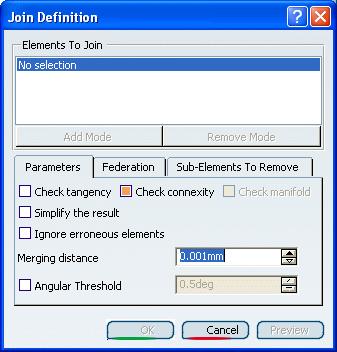
In Part Design workbench, the Join capability is available as a contextual command named Create Join that you can access from Sketch-based features dialog boxes.
Select the surfaces or curves to be joined.
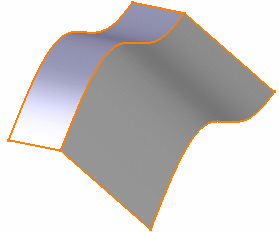
You can edit the list of elements to be joined:
- by selecting elements in the geometry:
- Standard selection (no button clicked): when you click an unlisted element, it is added to the list when you click a listed element, it is removed from the list
- Add Mode: when you click an unlisted element, it is added to the list when you click a listed element, it remains in the list
- Remove Mode: when you click an unlisted element, the list is unchanged when you click a listed element, it removed from the list
-
by selecting an element in the list then using the Clear Selection or Replace Selection contextual menu command.
Important: If you double-click Add Mode or Remove Mode, the chosen mode is permanent, i.e. successively selecting elements will add/remove them. However, if you click only once, only the next selected element is added or removed. You only have to click the button again, or click another one, to deactivate the mode.
- by selecting elements in the geometry:
Right-click the elements from the list and select Check Selection.
This lets you check whether an element to be joined presents any intersection (i.e. at least one common point) with other elements prior to creating the joined surface. If this command is not launched, possible intersections will not be detected.
The Checker dialog box is displayed, containing the list of domains (i.e. sets of connected cells) belonging to the selected elements from the Elements To Join list.

Click Preview.
- An information message is issued informing when no intersection is found ("No topological problem found").
-
When an element is self-intersecting, or when several elements intersect, a text is displayed on the geometry, where the intersection is detected.
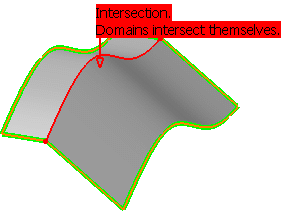
Click Cancel to return to the Join Definition box.
Right-click the elements again and choose one of the options below to allow the selection of elements of same dimension.
- Distance Propagation: the tolerance corresponds to the Merging distance value (as explained in step 14).
- Angular Propagation: the tolerance corresponds to the Angular Threshold value, if defined (as explained in step 15). Otherwise, it corresponds to the G1 tolerance value as defined in the part.
Each new element found by propagation of the selected element(s) is highlighted and added to the Elements To Join list.
Warning: - The initial element to propagate cannot be a sub-element,
- Forks stop the propagation,
- Intersections are not detected.
Click Preview in the Join Definition dialog box.
The joined element is previewed, and its orientation displayed. Click the red arrow to invert it if needed.
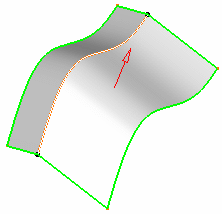
The join is oriented according to the first element in the list. If you change this element, the join's orientation is automatically set to match the orientation of the new topmost element in the list.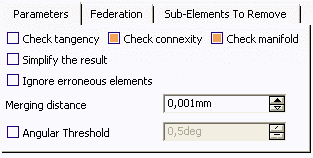
Select the Check tangency check box to find out whether the elements to be joined are tangent.
If they are not, and the option is selected, an error message is issued when you click Preview advising you to modify the selected inputs. Elements in error are highlighted in the 3D geometry once you have clicked OK in the Update Error dialog box:
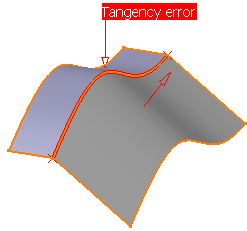
Important: This option works for an angular resolution of 0.5 degree. Select the Check connexity check box to find out whether the elements to be joined are connex. If they are not, and the option is selected, an error message is issued indicating the number of connex domains in the resulting join and elements in error are highlighted in the 3D geometry.
Tip: When clicking Preview, the free boundaries are highlighted, and help you detect where the joined element is not connex. Select the Check manifold check box to find out whether the resulting join is manifold.
Important: This option is only available with curves. Selecting it automatically enables Check connexity. Warning: Non-manifold configurations are not supported when joining surfaces. Select the Simplify the result check box to allow the system to automatically reduce the number of elements (faces or edges) in the resulting join whenever possible.
Select the Ignore erroneous elements check box to let the system ignore surfaces and edges that would not allow the join to be created.
You can also set the tolerance at which two elements are considered as being only one using the Merging distance.
Important: By default, the value is set to 0.001 mm and corresponds to the value defined in Tools > Options. To find out more about the merging distance value, refer to General Settings. Warning: It is not recommended to join two geometric elements with a merging distance exactly equal to the distance between these elements. Select the Angular Threshold check box and specify the angle value below which the elements are to be joined.
Tip: If the angle value on the edge between two elements is greater than the Angle Threshold value, the elements are not joined. This is particularly useful to avoid joining overlapping elements. Important: This option only applies to edges merged during the join computation. To compute the angle, the middle of each merged edge is taken into account. Click the Sub-Elements To Remove tab to display the list of sub-elements in the join.
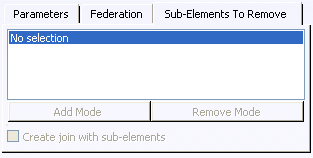
These sub-elements are elements making up the elements selected to create the join, such as separate faces of a surface for example, that are to be removed from the join currently being created.
You can edit the sub-elements list as described above (in step 3) for the list of elements to be joined.
Select the Create join with sub-elements check box to create a second join, made of all the sub-elements displayed in the list, i.e. those that are not to be joined in the first join.
Important: - This option is active only when creating the first join, not when editing it.
- It is not available when the joined surface belongs to an ordered geometrical set or a part body created in an hybrid environment.
- A message is displayed to inform you of the creation of a second join.
Click OK to create the joined surface or curve.
The surface or curve (identified as Join.xxx) is added to the specification tree.
| Tip: Sometimes elements are so close that it is not easy to see if they present a gap or not, even though they are joined. Select the Surfaces' Boundaries check box from the Tools > Options > General > Display > Visualization tab. |
![]()
Use the Federation Capability
The purpose of the federation is to regroup several elements making up the joined surface or curve that will be detected together with the pointer when selecting one of them.
This is especially useful when modifying linked geometry to avoid re-specifying all the input elements.
Create the join as usual, selecting all elements to be joined.
In the Join Definition dialog box, click the Federation tab, then select one of the elements making up the elements federation (providing the No federation and All propagation modes are not selected).
You can edit the list of elements taking part in the federation as described above (in step 3) for the list of elements to be joined.
Select a propagation mode, the system automatically selects the elements making up the federation, taking this propagation mode into account.
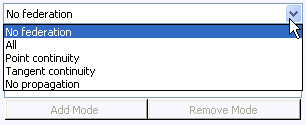
- No federation: no element can be selected
- All: all elements belonging to the resulting joined curve/surface are part of the federation. Therefore, no element can be explicitly selected.
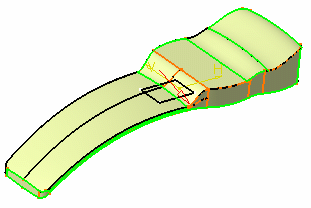
- Point continuity: all elements that present a point
continuity with the selected elements and the continuous elements
are selected.
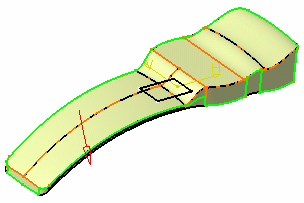
- Tangent continuity: all the elements that
are tangent to the selected element, and the ones tangent to it, are
part of the federation.
Here, only the top faces of the joined surface are
detected, not the lateral faces.
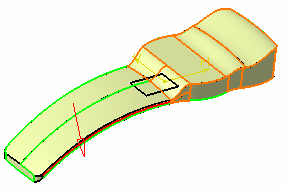
Important: To federate a surface and its boundaries in tangency, you need to select the face as well as the edges: both face and edges will be federated. - No propagation: only the elements explicitly selected are part of the federation.
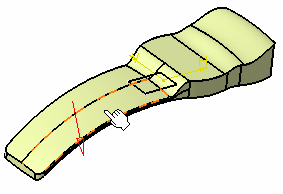
Select the Tangency continuity propagation mode.
Move to the Part Design workbench, select the sketch and click Pad
 to create an up to surface pad, using the joined surface as
the limiting surface.
to create an up to surface pad, using the joined surface as
the limiting surface.Select the front edge of the pad, click Edge Fillet
 and create a 2mm fillet.
and create a 2mm fillet.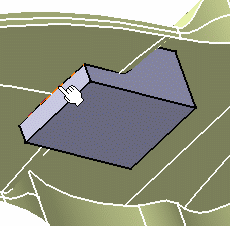
Double-click the sketch from the specification tree, then double-click the constraint on the sketch to change it to 10mm from the Constraint Definition dialog box.
Sketch prior to modification lying over two faces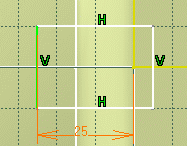 Sketch after modification lying over one face only
Sketch after modification lying over one face only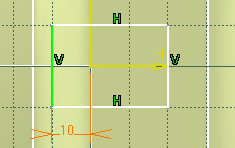
Exit the sketcher
 .
.The up to surface pad is automatically recomputed even though it does not lie over the same faces of the surface as before, because these two faces belong to the same federation. This would not be the case if the federation including all top faces would not have been created, as shown below.
Double-click the joined surface to edit it, and choose the No propagation mode.
Click OK in the Join Definition dialog box.
A warning message is issued, informing you that an edge no longer is recognized on the pad.
Click OK.
The Update Diagnosis dialog box is displayed, allowing you to re-enter the specifications for the edge, and its fillet. You then need to edit the edge and re-do the fillet to obtain the previous pad up to the joined surface.
Select the Edge.1 line, click the Edit button, and re-select the pad's edge in the geometry.
Click OK in the Edit dialog box.
The fillet is recomputed based on the correct edge.